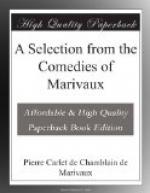The Theatre, or rather Theatres de la Foire, for there were two that were particularly noteworthy, that of Saint-Germain and that of Saint-Laurent, had had a more humble, though scarcely less early, origin than either of the other theatres just mentioned, for, as early as the year 1595, an ambulant troupe had played at the former of these two fairs. For many years their performances consisted largely of juggling, tumbling, tight-rope walking, and the like, interspersed perhaps with dialogues, which, in time, came to occupy the principal part. The characters were largely borrowed from the Italian commedia dell’arte. Extreme license of expression characterized these plays. Music often accompanied them. In fact the Theatre de la Foire was the germ that later developed into the Opera-Comique. Harrassed not only by the Theatre-Francais and the Theatre-Italien, but also by the Opera itself, they saw themselves obliged by the Court to abandon, in turn, dialogue and even monologue, and to depend upon placards as a means of expressing the plot to the audience. However, in spite of difficulties and opposition the Theatre de la Foire maintained its ground.
Among the authors writing for the Theatre-Francais were such celebrities as Crebillon pere,[59] Voltaire, Destouches, etc. No lesser names than those of Lesage and Piron were the support of the Theatre de la Foire. It remained for Marivaux to render illustrious the Italian stage[60].
Here it was, then, on the fourth of March, 1720, that he made his debut before the public with a comedy in three acts, l’Amour et la Verite. It may be recalled that Crispin l’heureux fourbe had been presented only in private. Perhaps to give himself confidence in a line as yet almost untried, and which, after his boasting of fourteen years before and his rather unsuccessful attempt, he had come to consider as not so “easy” after all, he may have sought the aid of one of his co-workers on the Mercure. At any rate, the play was written in collaboration with the Chevalier de Saint-Jory, and was the only piece in which Marivaux accepted similar aid, “except for the musical diversions of his plays."[61] L’Amour et la Verite failed to please the public, but, as it was never printed, we cannot judge of its merits.
However, that same year, Marivaux amply retrieved himself in the exquisite fairy-play of Arlequin poli par l’Amour, a comedy in one act, presented at the Theatre-Italien, October 20, and which Jules Lemaitre characterizes as perhaps of all his plays “the most purely poetical, in spite of the excess of esprit, and the one in which fancy is the freest."[62] It was greeted by the public with enthusiasm, and even such severe critics of Marivaux as La Harpe could find little to say against it,—that it “lacked intrigue” and had a “weak denouement " possibly, but after all that he had made of Harlequin, “of that ideal personage, who up to that time had only known how to provoke laughter,” an “interesting” character “by making him in love."[63]




